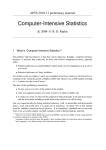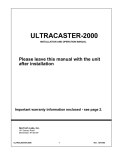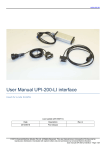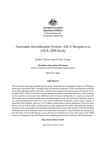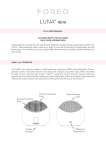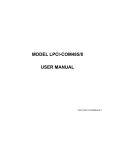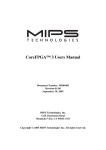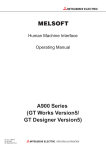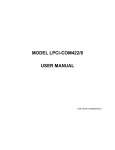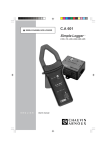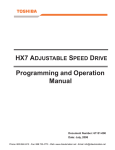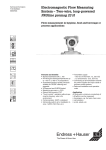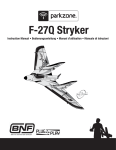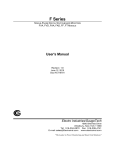Download Canon EF-232 Library User Manual 1.3
Transcript
Canon EF-232 Library
User Manual
© 1999-2009 Birger Engineering, Inc.
Manual Rev 1.3
10/16/09
This manual covers library versions up to 20c and bootloader versions up to 45.
Birger Engineering, Inc.
38 Chauncy St #1101
Boston, MA 02111
http://www.birger.com
Go to Table of Contents
2
1
Table of Contents
1 Table of Contents.......................................................................................3
2 Quick Reference Tables............................................................................5
Table 1. Library Command Quick Reference..........................................................5
Table 2. Bootloader Command Quick Reference.....................................................7
3 General Notes on Using the Library........................................................8
3.1 Bootloader vs. Library............................................................................................8
3.2 Aperture Positioning...............................................................................................8
3.3 Legacy Focus Positioning.......................................................................................8
3.4 Mapped Absolute Focus Positioning.....................................................................9
3.5 Focus Drift...............................................................................................................9
3.6 Legacy vs. New Commands....................................................................................9
3.7 Blocking vs. Non-Blocking Commands...............................................................10
3.8 Terse vs. Verbose Reporting Modes....................................................................10
3.9 Status Strings.........................................................................................................11
3.9.1 Focus Position Status.......................................................................................11
3.9.2 Aperture Position Status...................................................................................11
3.9.3 Focal Length and Aperture Range Status........................................................11
3.9.4 Miscellaneous Status Flags..............................................................................12
Table 3. Status Flags.............................................................................................12
3.9.5 Lens Connection Messages..............................................................................12
3.10 Errors in Command Processing.........................................................................12
Table 4. Error Codes.............................................................................................13
4 How to Read the Command References................................................14
5 Library Command Reference................................................................15
5.1 Bootloader Version (bv)........................................................................................16
5.2 Define Aperture (da).............................................................................................17
5.3 Dump EEPROM (de)............................................................................................18
5.4 Distance Stops (ds)................................................................................................19
5.5 Define Zoom (dz)...................................................................................................20
5.6 Servo Focus with Checksum (eh).........................................................................21
5.7 Exit to Bootloader (ex)..........................................................................................22
5.8 Focus Absolute (fa)...............................................................................................23
5.9 Focus Distance (fd)................................................................................................24
5.10 Fast Focus (ff)......................................................................................................25
5.11 Focus Positions (fp).............................................................................................26
5.12 Get Statuses (gs)..................................................................................................27
5.13 Hardware Version (hv).......................................................................................28
5.14 Lens Identification (id).......................................................................................29
5.15 Initialize Aperture (in)........................................................................................30
5.16 Image Stabilization (is).......................................................................................31
5.17 Learn Absolute Focus Range (la)......................................................................32
5.18 Cached Extended Lens Status (lc).....................................................................33
5.19 Library Loaded (ll).............................................................................................34
Go to Table of Contents
3
5.20
5.21
5.22
5.23
5.24
5.25
5.26
5.27
5.28
5.29
5.30
5.31
5.32
5.33
5.34
5.35
5.36
5.37
5.38
5.39
5.40
5.41
Lens Presence (lp)...............................................................................................35
Immediate Extended Lens Status (ls)................................................................36
Library Version (lv)............................................................................................37
Move Aperture Absolute (ma)...........................................................................38
Move Aperture to Closed Position (mc)............................................................39
Move Focus Incremental (mf)............................................................................40
Move Focus to Infinity (mi)................................................................................41
Move Aperture Incremental (mn).....................................................................42
Move Aperture to Opened Position (mo)..........................................................43
Move Focus to Zero (mz)....................................................................................44
Print Aperture Position (pa)..............................................................................45
Print Focus Position (pf).....................................................................................46
Lens Power (pl)...................................................................................................47
Set Response Modes (rm)...................................................................................48
Set EEPROM Byte (se).......................................................................................49
Set Focus Counter Offset (sf).............................................................................50
Set GPIO (sg).......................................................................................................51
Set Special Modes (sm).......................................................................................52
Print Serial Number (sn)....................................................................................53
Set Spontaneous Responses (sr).........................................................................54
Short Version String (vs)....................................................................................55
Write EEPROM Parameters (we).....................................................................56
6 Bootloader Command Reference...........................................................57
6.1 Banner Echo (be)...................................................................................................58
6.2 Boot Library (bl)...................................................................................................59
6.3 Baud Rate (br).......................................................................................................60
6.4 Baud Store (bs)......................................................................................................61
6.5 Hardware Version (hv).........................................................................................62
6.6 Library Version (lv)..............................................................................................63
6.7 Query Communications Port (qp).......................................................................64
6.8 Set Response Modes (rm).....................................................................................65
6.9 Escape from Port Routing (routeesc,).................................................................66
6.10 Setup Port Routing (rt).......................................................................................67
6.11 Serial Number (sn)..............................................................................................68
6.12 Suppress Prompt (sp)..........................................................................................69
6.13 Long Version String (vn)....................................................................................70
6.14 Short Version String (vs)....................................................................................71
6.15 Write Configurations to EEPROM (wc)...........................................................72
6.16 XModem Firmware Download (xm).................................................................73
Go to Table of Contents
4
2
Quick Reference Tables
Table 1. Library Command Quick Reference
Command
bv
da
de
ds
dz
eh
ex
fa
fd
ff
fp
gs
hv
id
in
is
la
lc
ll
lp
ls
lv
ma
mc
mf
mi
mn
mo
mz
pa
pf
pl
rm
se
sf
sg
sm
sn
Arguments
Description
Print the bootloader version.
Print aperture information.
Dump EEPROM.
Print distance stops.
Print the zoom range.
pos,checksum Set absolute lens focus position (0…0x3FFF).
Exit to the bootloader.
position
Move focus to absolute position.
Print focus distance range.
position
Fast focus.
Print the raw focus positions.
Echo current device and lens statuses.
Print the hardware version.
Print basic lens identification (zoom and f-number).
Initialize the aperture motor. Aperture will fully open.
{0, 1}
Turn image stabilization off/on.
options
Learn the focus range.
Print cached lens status
Library loaded check.
Lens presence.
Query lens for status immediately and print.
Print the library version string.
stop
Move aperture to absolute position.
Move aperture to the fully stopped down limit.
Move focus incremental.
Move focus to the infinity stop.
num_stops
Move aperture incremental.
Move aperture to completely open.
Move focus to the zero stop.
Print the aperture position.
Print the focus position.
{0, 1}
Lens power
verbose[,new] Set response modes.
byte,val
Temporarily set non-volatile (EEPROM) byte.
count
Set the focus counter.
port,state
Set GPIO.
mode_flags Set special modes.
Print the device serial number.
Go to Table of Contents
5
sr
vs
we
{0, 1}
Set spontaneous responses off/on.
Print the short version string.
serial_number Write non-volatile parameters to EEPROM.
Go to Table of Contents
6
Table 2. Bootloader Command Quick Reference
Command
be
bl
br
bs
hv
lv
qp
rm
routeesc,
rt
sn
sp
vn
vs
wc
xm
Arguments
baud_rate[,prt]
verbose[,new[,prt]]
depth
port,depth
{0, 1}
unlock_sn
Go to Table of Contents
Description
Print the banner string.
Boot library.
Set baud rate, argument is actual baud rate / 100.
Obsolete – commit baud rate setting.
Print the hardware version.
Print version of loaded library.
Query current port number.
Set response modes.
Escape from port routing.
Route through to port with assigned depth.
Print the unit serial number.
Suppress prompt.
Print the long version string.
Print the short version string.
Write all configurations to EEPROM.
XModem firmware download.
7
3
General Notes on Using the Library
This section describes the differences between legacy library commands (libraries
up to version 15) and new library commands (versions 16 and upward), the differences in
command behavior, and the differences between the bootloader and library. It is also the
reference for the basic behaviors of the library.
3.1
Bootloader vs. Library
Prior to version 16 of the library, the bootloader and library code were integrated
together. While the library was still separately upgradeable, the bootloader and library
worked together. All commands were available for access all of the time. All commands
blocked until they were finished.
Version 4 of the hardware shipped with a new bootloader and new command
model. Bootloader commands are only available from within the bootloader, and library
commands are only available from within the library, except where the functionality is
duplicated. If a command with the same name exists in the bootloader and library then it
will perform the same function in both instances.
The bootloader transfers execution to the library for normal operation, and the
library handles normal command processing. Commands can be blocking or nonblocking (they return immediately while lens processing occurs “in the background”).
Firmware upgrading can only be done through the bootloader.
3.2
Aperture Positioning
Aperture positioning is generally measured in ¼ stop increments. However, the
input to the aperture positioning commands is an integer and the reported aperture
positions are f-number times ten or a corresponding integer number of ¼ stops. For
example, if f28 is reported for an aperture position, then it is indicating that the actual fnumber is 2.8. If this is the wide-open position then it is considered the zero position, and
the input to the absolute aperture position commands would be zero. If aperture
measurement is not reported as ¼ stops then the exception will be noted where
applicable.
A value of one would indicate ¼ stop from the full-open position (2.8) towards
the closed position, which would be approximately 3.1. If the aperture position is then
reported in this state, the number one would be reported as the position in number of ¼
stops from the wide-open (zero) position, and the f-number would be reported as f30.
Note that the library uses integer rather than floating point math, so the f-number reported
is close to, but not exactly the mathematical f-number.
3.3
Legacy Focus Positioning
Focus positioning for legacy commands is performed with respect to the encoder
positions directly reported by the connected lens. Each lens will have a different encoder
count for its focusable range, and the encoder count for the zero position will almost
Go to Table of Contents
8
never be zero, in fact it will usually be random, changing with each power cycle of the
lens. However, the focus counter command 'sf' can be used to make any number the
reference for the zero position. The lens can be focused anywhere from zero to infinity by
using commands to learn the full encoder count range and then applying those values to
the positioning commands. For example, a move to zero and then a set focus counter to
zero will establish the value of zero as the position for the minimum focus distance of the
lens. A move to infinity will then report the full number of encoder counts that it took to
get there.
3.4
Mapped Absolute Focus Positioning
Library versions 16 and up introduce the ability to perform absolute positioning
on a fixed scale. This fixed scale is a 14-bit range from 0 to 16383 (hex 3FFF). The range
of the lens from the zero stop to the infinity stop is mapped into this numerical scale. The
14-bit range is generally much larger than the encoder range returned by the lens, and
therefore a small change in the mapped position often will not result in a change to the
focus position.
The mapped focusing feature is highly recommended when using a control
surface to alter focusing. It allows use of a scale that is always fixed between the zero and
infinity positions. However, if the control surface is not capable of sending small enough
changes in the mapped position, then jumpy focusing behavior can occur. Ideally the
control surface should also have a 14-bit range, but a smaller range is okay as long as it is
several times larger than the lens' encoder range. The control surface should have at least
12-bit resolution to meet this requirement for all lenses tested to date. A smaller
resolution will still work, but focusing will not be as smooth or precise.
3.5
Focus Drift
Most lenses will experience drift of the focus mechanism. This results in a change
of the encoder position associated with a particular stop. Generally the lens will lose or
gain a few encoder counts when hitting a stop. The lens may also lose positioning just
during normal focusing, and it can be made worse if the focus move is small. The betterconstructed, more-expensive lenses will drift far less than the cheaper lenses. Drift must
be accounted for by relearning the encoder positions of the zero and infinity stops.
3.6
Legacy vs. New Commands
The library as shipped emulates the legacy command protocol. In this protocol all
commands are case insensitive and are acknowledged with the string 'OK' to indicate that
the command was received. This is followed by any output that the command may have,
after any delay that the command may need to complete its processing. Commands that
are marked as 'new' in this manual will still conform to this behavior.
It is possible to change this behavior so that the 'OK' string is not emitted. In this
case commands will report only their output, or a confirmation if they have no regular
output. These modes can be configured with the response mode command, and are
Go to Table of Contents
9
described further under that command heading. When the new library protocol is active,
commands become case-sensitive. They must be entered as lower-case only.
There are general enhancements that apply regardless of mode or command.
White space is now permitted and commands can have multiple arguments, each
separated by a comma.
3.7
Blocking vs. Non-Blocking Commands
In the legacy libraries (versions 15 and lower), all commands were blocking. In
other words, they needed to finish before any other command could be sent. The new
libraries introduce two new servo routines: an aperture servo and a focus servo. There are
new commands to use these routines. These new commands return immediately and the
library handles the necessary lens processing in the background.
If you intend to have multiple devices talking to the lens controller over several
serial ports, then all lens commands and status queries must use the new commands that
operate in the background. Otherwise, a device on one port will hold off the other devices
from getting their communications through in a timely manner. Also, the library
automatically coordinates the lens processing so no conflicts occur, which would not be
possible if using the legacy commands from multiple serial ports.
3.8
Terse vs. Verbose Reporting Modes
The device can be configured to report in two different modes in addition to
legacy/new protocols using the response modes ('rm') command. In terse mode,
characters are not echoed back from the device, and all commands return a single
number, zero for no error or a non-zero error value. Note that even commands that would
normally return a status string will not do so in terse mode as long as they are marked as
legacy commands. New commands will always echo their output if they have status to
print.
In verbose mode, all characters input to the device are echoed back out, and
commands will print their full status strings as usual. If set to both verbose and new
protocol modes, then a question mark will be emitted by the device for unknown
commands. Verbose mode is most useful when manually controlling the device through a
terminal program.
Go to Table of Contents
10
3.9
Status Strings
Starting with library version 18, there are a standard set of status strings that can
be queried for or spontaneously emitted from the device. The spontaneous emissions are
off by default but can be turned on with the command 'sr'.
3.9.1
Focus Position Status
Format: %:xxxx
Where xxxx is a 4-digit hexadecimal number indicating the current focus position
of the lens in the mapped range (0...3FFF).
3.9.2
Aperture Position Status
Format: &:xx
Where xx is a 2-digit hexadecimal number indicating the current aperture position
in 1/8 stops. Note that if the aperture position is unknown, for example if a lens has been
connected but not initialized, then the status string will be:
&:?
3.9.3
Focal Length and Aperture Range Status
Format: @:<focal_length>mm,f<min_f>,<num_stops>,f<max_f>
Where <focal_length> is a decimal number for the current focal length in
millimeters, <min_f> is a decimal number for the current minimum f-number times ten,
<num_stops> is a decimal number for the number of ¼ stops available, and <max_f> is a
decimal number for the current maximum f-number times ten.
Go to Table of Contents
11
3.9.4
Miscellaneous Status Flags
Format: #:xxxx
Where xxxx is a 4-digit hexadecimal number indicating the current value of the
flags. The flags are given in the following table.
Table 3. Status Flags
Bit(s)
Description
0
Port RA0 is input; 0 = output, 1 = input.
1
Port RA1 is input; 0 = output, 1 = input.
2
Port RA0 value; 0 = low, 1 = high.
3
Port RA1 value; 0 = low, 1 = high.
4
Aperture initialized; 0 = not initialized, 1 = initialized.
5
Manual focus; 0 = lens is in autofocus, 1 = lens in in manual focus.
6
Focus mode; 0 = normal; 1 = sticky lenses
7-15
3.9.5
Reserved.
Lens Connection Messages
When in new-protocol mode, a spontaneous string will be emitted when a lens is
connected or disconnected from the unit. These strings are:
Lens Connected.
and
Lens Disconnected.
3.10 Errors in Command Processing
If a command fails it will report a numerical error code. In terse mode the number
is returned by itself, while in verbose mode and new-protocol mode the return string will
be:
ERRx
Where x is the numerical error code. The possible error codes that can be returned are
given in the following table.
Go to Table of Contents
12
Table 4. Error Codes
Error Code Description
0
No error.
1
Unrecognized command.
2
Lens is in manual focus mode.
3
No lens connected.
4
Lens distance stop error.
5
Aperture not initialized.
6
Invalid baud rate specified.
7
Reserved.
8
Reserved.
9
A bad parameter was supplied to the command.
10
XModem timeout.
11
XModem error.
12
XModem unlock code incorrect.
13
Not used.
14
Invalid port.
15
License unlock failure.
16
Invalid license file.
17
Invalid library file.
18
Reserved.
19
Reserved.
20
Not used.
21
Library not ready for lens communications.
22
Library not ready for commands.
23
Command not licensed.
24
Invalid focus range in memory. Try relearning the range.
25
Distance stops are not supported by the lens.
Go to Table of Contents
13
4
How to Read the Command References
Each command page is organized as follows:
Applicable Library
Versions
Command Name (command)
Command Type
Syntax
: New/Legacy or both
: What is entered as the complete command
Returns
: The information or exact string returned
Description
A description of how the command is used.
Examples:
One or more examples of how the command is used. The command syntax is
shown as normal text, information returned from the device is shown in italic text. The
command confirmation for legacy behavior ('OK') is not shown.
Go to Table of Contents
14
5
Library Command Reference
The following pages contain descriptions of the commands that are available from
within the library. These commands will not be active while in the bootloader, however
the bootloader may have commands with the same name also implemented, in which case
they will perform the same function.
Go to Table of Contents
15
v18+
5.1
Bootloader Version (bv)
Command Type
Syntax
: New
: bv
Returns
: Bootloader version number
Description
This command will print the version of the bootloader code from within the
library. Therefore exiting to the bootloader is not needed to read the revision information.
Example:
bv <CR>
44
Go to Table of Contents
16
v10+
5.2
Define Aperture (da)
Command Type
Syntax
: Legacy
: da
Returns
: f<min>,<num_stops>,f<max>
Description
This command will print the the aperture range of the connected lens. The range
is printed in three parts as follows:
fmin,num_stops,fmax
The item printed is the letter 'f' followed by the current minimum f-number. This is
followed by a comma and the total number of stops in ¼ stops that can be commanded to
the lens. This is then followed by another comma, the letter 'f', and the current maximum
f-number.
Example:
da <CR>
f28,28,f320
Go to Table of Contents
17
v18+
5.3
Dump EEPROM (de)
Command Type
Syntax
: New
: de
Returns
: EEPROM parameters as hexadecimal bytes
Description
This command will dump a hexadecimal stream of bytes that corresponds to the
non-volatile parameters stored in EEPROM. The commonly configured parameters are
almost always available through other commands, so this command is used to gain access
to the remaining parameters. These parameters are often low-level timing configurations.
Contact Birger Engineering if you think your programming needs might require
modification to these parameters.
Go to Table of Contents
18
v18+
5.4
Distance Stops (ds)
Command Type
Syntax
: New
: ds
Returns
: $:<far>:<near>:<encoder>
Description
This command will execute a move to the zero stop of the lens. It will then
advance the lens through its focus range and print the distance stops as reported by the
lens. The distance stops take the form:
$:<far>:<near>:<encoder>
Where <far> is a 4-digit hexadecimal number representing the far distance of the stop in
centimeters, <near> is another 4-digit hexadecimal number representing the near distance
of the stop in centimeters, and <encoder> is a 4-digit hexadecimal number of the raw
encoder count of the lens. The command finishes with a move to the focus motor infinity
stop to read its position followed by a return to the original focus position. Issuing this
command while it is already in progress will cancel further distance reporting. Other lens
control commands will not work or should not be issued while this command is in
progress.
The infinity position is reported as ffff hexadecimal. The infinity position reported
as a distance stop may not actually correspond with the infinity focus position resulting
from the focus motor's infinity stop. These are often two different stops in the lens
construction. Not all lenses are capable of reporting distance stops.
Example:
ds <CR>
$:0021:0020:fe01
$:0023:0021:feb4
$:0025:0023:ff23
$:0026:0025:ffb1
$:0029:0026:0066
$:0035:0029:0216
$:005f:0035:0436
$:008b:005f:04f6
$:017a:008b:05e8
$:045d:017a:062f
$:ffff:045d:0655
$:ffff:ffff:06bf
$:DONE
Go to Table of Contents
19
v10+
5.5
Define Zoom (dz)
Command Type
Syntax
: Legacy
: dz
Returns
: <min_focal_length>mm,<max_focal_length>mm
Description
This command will print the zoom range of the lens. The first number printed is
the minimum focal length in millimeters followed by 'mm'. This is followed by a comma,
the maximum focal length of the lens, and the letters 'mm'. Prime lenses will print the
same value for minimum and maximum focal length.
Example:
dz <CR>
18mm,55mm
dz <CR>
50mm,50mm
Go to Table of Contents
20
v16+
5.6
Servo Focus with Checksum (eh)
Command Type
Syntax
: New
: eh <absolute_position>,<checksum>
Returns
: Nothing
Description
This command is used to set the focus position of the lens on an absolute 14-bit
scale from 0 to 3FFF hexadecimal. The command requires a checksum that is the bit-wise
exclusive-OR of the four 4-bit digits of the position. This command executes through the
servo focus routine and returns immediately.
All four digits of the position must be specified, including leading zeros. If the
correct number of digits is not sent or the checksum is incorrect, then the command will
be ignored.
Examples:
eh0000,0 <CR>
eh1000,1 <CR>
eh3fff,c <CR>
Go to Table of Contents
21
v16+
5.7
Exit to Bootloader (ex)
Command Type
Syntax
: New
: ex
Returns
: In bootloader!
Description
This command exits library processing and hands control to the bootloader.
Firmware (library) upgrades must be performed through the bootloader. There are several
other commands that can only be accessed through the bootloader.
The return response from this command depends on which protocol mode is
active, legacy vs. new, and terse vs. verbose, but the string 'In bootloader!' will always be
returned.
Examples:
ex <CR>
r!
In bootloader!
ex <CR>
BEI Boot Executive, v44
(c)2008 Birger Engineering, Inc.
In bootloader!
Go to Table of Contents
22
v11+
5.8
Focus Absolute (fa)
Command Type
Syntax
: Legacy
: fa <position>
Returns
: DONE<rposition>,<flag>
Description
This command makes the focus mechanism move to the specified focus count
position, specified in counts moved in <position>. If an input value would move the
focus out of the legal range the value is rounded to the boundary (i.e. min/max count).
<rposition> is the actual position that the count has been moved to, <flag> is 1 if the lens
reports having hit a stop, and 0 if it hasn't. Note that some lenses do not return a 1 until
the second time the stop is hit.
Examples:
fa100 <CR>
DONE100,0
fa2000 <CR>
DONE1759,1
Go to Table of Contents
23
v10+
5.9
Focus Distance (fd)
Command Type
Syntax
: Legacy
: fd
Returns
: <near>cm,<far>cm
Description
The number is returned as two distances, <near> the near distance, and <far> the
far distance, both in centimeters, where 65535 represents infinity. Not all lenses return
distance information. This information corresponds to what the lens reports as the stops
that bracket the current focus position, not as the near and far focal distances as
determined by the actual optics involved, which are calculations based on the lens focal
length, aperture, focusing distance, and circle-of-confusion.
Examples:
fd <CR>
45cm,48cm
fd <CR>
65535cm,65535cm
Go to Table of Contents
24
v15+
5.10 Fast Focus (ff)
Command Type
Syntax
: Legacy/New
: ff <position>
Returns
: DONE
Description
This command has been updated to use the servo focus routine. The position
supplied uses the legacy focus positioning, which are encoder counts as reported by the
lens with the applied offset set through the focus counter command 'sf'.
Example:
ff1000 <CR>
DONE
Go to Table of Contents
25
v16+
5.11 Focus Positions (fp)
Command Type
Syntax
: New
: fp
Returns
: fmin:<fmin> fmax:<fmax> current:<current_pos>
Description
This command will print the focus positions in raw encoder counts as reported by
the lens. The positions are reported as signed decimals, and as they are raw encoder
counts, do not have the focus counter offset applied. <fmin> is the zero position of the
lens and is updated every time the lens is commanded to the zero stop with the 'mz'
command. <fmax> is the infinity position of the lens and is updated every time the lens is
commanded to the infinity position with the 'mi' command. Both positions are updated if
the learn focus range ('la') command is issued. <current_pos> is the current focus position
of the lens.
Example:
fp <CR>
fmin:-1303
fmax:1228
Go to Table of Contents
current:696
26
v18+
5.12 Get Statuses (gs)
Command Type
Syntax
: New
: gs
Returns
: Status strings
Description
This command prints complete status information in the form of the new status
strings. The status strings are described in Section 3.9 of this manual.
Example:
gs <CR>
%:1948
&:0a
@:100mm,f28,28,f320
#:0010
Go to Table of Contents
27
v18+
5.13 Hardware Version (hv)
Command Type
Syntax
: Legacy/New
: hv
Returns
: Device hardware version
Description
This command will print the hardware version of the device. It exists up to library
version 15 in the unified bootloader/library. The command does not appear in versions 16
and 17 of the library, so obtaining the hardware version requires exiting to the bootloader
for those versions.
Example:
hv <CR>
4
Go to Table of Contents
28
v10+
5.14 Lens Identification (id)
Command Type
Syntax
: Legacy
: id
Returns
: <current_focal_length>mm,f<current_min_f_number>
Description
This command prints the basic lens identity. For a zoom lens it will print the
current focal length, otherwise it prints the fixed focal length of the lens. This is followed
by a comma and the letter 'f' followed by the current minimum f-number that the lens is
capable of multiplied by ten.
Examples:
id <CR>
38mm,f47
id <CR>
100mm,f28
Go to Table of Contents
29
v10+
5.15 Initialize Aperture (in)
Command Type
Syntax
: Legacy
: in
Returns
: DONE
Description
This command initializes the aperture motor and position. This opens up the
aperture to its minimum f-number (maximum opening). This position is then set as the
zero position for all subsequent aperture movement commands. This is required before
any of the aperture movement commands can be used, as driving the aperture motor too
far without knowing its position could damage the aperture mechanism. The library
prevents you from issuing aperture movement commands unless the position has first
been initialized with this command.
Example:
in <CR>
DONE
Go to Table of Contents
30
v10+
5.16 Image Stabilization (is)
Command Type
Syntax
: Legacy/New
: is {0, 1}
Returns
: DONE
Description
Legacy: Up to version 17 of the library, this command turns on the image
stabilization function of the lens. This command blocks until any character is input into
the device or power is removed, so no other commands can be issued while it is active.
New: Version 18 of the library introduces the ability to turn this function on or off
as a background process. In most cases lenses with image stabilization will already have
the function active without needing this command. In that case, image stabilization
should be turned on or off using the switch on the lens barrel. Lenses that use full-time
manual focus, such as the Canon EF 85mm f/1.2 L II USM need to have this turned on or
they will not be able to be focused manually.
Examples:
is0 <CR>
DONE
is1 <CR>
DONE
Go to Table of Contents
31
v16+
5.17 Learn Absolute Focus Range / Detect Lens (la)
Command Type
Syntax
: New
: la [<options{0,1,2}>]
Returns
: DONE:LA
Description
This command learns the focus range of the lens for the servo focus routine and
also for any legacy commands in a single step. No other lens movement commands can
be issued while this command is in progress. This command does not block, so other
commands that don't require lens communications can be issued while the lens is
focusing. A confirmation will be emitted by the device when the lens has completed
focusing. The servo focusing and mapped focus range will not function unless the lens
focus range is learned.
This command can also be supplied with an argument that starts the lens detection
process at different stages.
Option:
0
1
2
Same as LA without arguments – learn the lens' focal range.
Resynchronize with the lens.
Re-detect and resynchronize with the lens.
Examples:
la <CR>
DONE:LA
la1 <CR>
DONE:LA
la2 <CR>
DONE:LA
Go to Table of Contents
32
v18+
5.18 Cached Extended Lens Status (lc)
Command Type
Syntax
: New
: lc
Returns
: @:<focal_length>mm,f<min_f>,<num_stops>,f<max_f>
Description
This command will print the extended lens status from cached information. The
status string is of the form outlined in Section 3.9. Cached information is updated
periodically by the library if background querying is turned on (see command 'sm'). If
multiple devices are interfacing to the lens controller over multiple serial ports, then this
command should be used to retrieve status, as it will avoid conflicts.
Example:
lc <CR>
@:38mm,f47,21,f293
Go to Table of Contents
33
v18+
5.19 Library Loaded (ll)
Command Type
Syntax
: New
: ll
Returns
: OK
Description
This command simply prints 'OK'. It can be used as a test to see if the device is
executing library code or bootloader code. The command does not exist in the bootloader,
and therefore will not work unless library code is being executed.
Example:
ll <CR>
OK
Go to Table of Contents
34
v16+
5.20 Lens Presence (lp)
Command Type
Syntax
: New
: lp
Returns
: 0 or 1
Description
This command will indicate if a lens is currently connected or not. It prints the
number '0' when no lens is connected and '1' when a lens is connected.
Examples:
lp <CR>
0
lp <CR>
1
Go to Table of Contents
35
v16+
5.21 Immediate Extended Lens Status (ls)
Command Type
Syntax
: New
: ls
Returns
: @:<focal_length>mm,f<min_f>,<num_stops>,f<max_f>
Description
This command will print the extended lens status by immediately querying the
lens. The status string is of the form outlined in Section 3.9. This command should be
used if background querying is turned off (see command 'sm').
Example:
ls <CR>
@:38mm,f47,21,f293
Go to Table of Contents
36
v10+
5.22 Library Version (lv)
Command Type
Syntax
: Legacy
: lv
Returns
: Full library identity string
Description
This command prints the full library identification string.
Example:
lv <CR>
Canon EF-232 Library v17
Go to Table of Contents
37
v10+
5.23 Move Aperture Absolute (ma)
Command Type
Syntax
: Legacy
: ma <pos>
Returns
: DONE<rpos>,f<f_number>
Description
This command moves the aperture mechanism to the specified encoder position,
specified in ¼ stops from the fully-open position, indicated by the user in <pos>. If an
input value would move the aperture out of the legal range the value is set to the
boundary (i.e. min/max aperture). <rpos> is the actual position the aperture moved to in
¼ stops from the fully-open position, and <f_number> is the absolute position given as
the lens f-number times ten.
Examples:
ma0 <CR>
DONE0,f35
ma5 <CR>
DONE5,f54
Go to Table of Contents
38
v10+
5.24 Move Aperture to Closed Position (mc)
Command Type
Syntax
: Legacy
: mc
Returns
: DONE<signed_num_steps>,f<f_number>
Description
This command will move the aperture to the fully closed position. The number of
steps in ¼ stops that the aperture actually moved is given in <signed_num_steps>. The
final position is given in <f_number> as the lens f-number times ten.
Example:
mc <CR>
DONE14,f216
Go to Table of Contents
39
v10+
5.25 Move Focus Incremental (mf)
Command Type
Syntax
: Legacy
: mf <signed_counts>
Returns
: DONE<signed_num_counts>,<flag>
Description
This command makes the focus mechanism move incrementally the number of
counts specified in <signed_counts>. If the number specified is positive then the focus
moves towards the infinity position. If the number is negative then the focus moves
towards the zero position. If the number of counts specified is out of range, the
mechanism will move as far as it can, <signed_num_counts> is the actual number of
counts moved, and <flag> is 1 if the lens reports having hit a stop, 0 if it hasn't. Note that
some lenses do not return a 1 until the second time the stop is hit.
Examples:
mf100 <CR>
DONE100,0
mf-50 <CR>
DONE-50,0
Go to Table of Contents
40
v10+
5.26 Move Focus to Infinity (mi)
Command Type
Syntax
: Legacy
: mi
Returns
: DONE<signed_num_counts>,<flag>
Description
This command moves the lens focus to the infinity position. The actual number of
counts moved as reported by the lens' encoder is given in <signed_num_counts>. <flag>
is 1 if the lens reports having hit a stop, 0 if it hasn't. Note that some lenses do not return
a 1 until the second time the stop is hit.
Example:
mi <CR>
DONE246,1
Go to Table of Contents
41
v10+
5.27 Move Aperture Incremental (mn)
Command Type
Syntax
: Legacy
: mn <signed_steps>
Returns
: DONE<num_signed_steps>,f<f_number>
Description
This command moves aperture mechanism the specified number of steps, in the
specified direction, in ¼ stops given by <signed_steps>. A positive step is a move
towards the fully closed position and a negative step is a move towards the fully opened
position. If an input value would move the aperture out of the legal range the value is
clipped to the boundary (i.e. min/max aperture). <num_signed_steps> is the actual
number of steps the aperture was moved, and <f_number> is the absolute position of the
aperture after executing the move, in the lens f-number times ten.
Examples:
mn2 <CR>
DONE2,f54
mn-1 <CR>
DONE-1,f49
Go to Table of Contents
42
v10+
5.28 Move Aperture to Opened Position (mo)
Command Type
Syntax
: Legacy
: mo
Returns
: DONE<signed_num_steps>,f<f_number>
Description
This command will move the aperture to the fully open position. The number of
steps in ¼ stops that the aperture actually moved is given in <signed_num_steps>. The
final position is given in <f_number> as the lens f-number times ten.
Example:
mo <CR>
DONE-21,f35
Go to Table of Contents
43
v10+
5.29 Move Focus to Zero (mz)
Command Type
Syntax
: Legacy
: mz
Returns
: DONE<signed_num_counts>,<flag>
Description
This command moves the lens focus to the zero position. The actual number of
counts moved as reported by the lens' encoder is given in <signed_num_counts>. <flag>
is 1 if the lens reports having hit a stop, 0 if it hasn't. Note that some lenses do not return
a 1 until the second time the stop is hit.
Example:
mz <CR>
DONE-1246,1
Go to Table of Contents
44
v10+
5.30 Print Aperture Position (pa)
Command Type
Syntax
: Legacy
: pa
Returns
: <pos>,f<f_number>
Description
This command prints the current position of the aperture. <pos> is the absolute
position given in ¼ stops from the fully-open position and <f_number> is the absolute
position given as the lens f-number times ten.
Example:
pa <CR>
5,f54
Go to Table of Contents
45
v10+
5.31 Print Focus Position (pf)
Command Type
Syntax
: Legacy
: pf
Returns
: Signed focus position in encoder counts.
Description
This command prints the current position of the focus mechanism given in
encoder counts with the user's desired focus counter offset applied.
Examples:
pf <CR>
-1247
pf <CR>
743
Go to Table of Contents
46
v16+
5.32 Lens Power (pl)
Command Type
Syntax
: Legacy
: pl {0, 1}
Returns
: Current setting
Description
This command does not perform any function. It is included for legacy
compatibility only.
Examples:
pl1 <CR>
1
pl0 <CR>
0
Go to Table of Contents
47
v16+
5.33 Set Response Modes (rm)
Command Type
Syntax
: Legacy/New
: rm <verbose{0, 1}>[, <new{0, 1}>]
Returns
: OK or 0
Description
This command is used to set the response modes. The first argument can be 0 or
1, representing terse mode or verbose mode, respectively. In verbose mode all characters
sent to the device are echoed back out and most commands return confirmations and full
status strings. In terse mode, no characters are echoed and command responses are
limited to error codes for legacy behavior. The second argument is optional (if not
supplied it defaults to 0), and indicates the protocol mode – legacy (0) or new (1). Legacy
mode maintains protocol compatibility with libraries version 15 and earlier.
The response modes are set on a per-port basis, the change being effective for the
port over which the command is sent.
Examples:
rm0,1 <CR>
OK
rm0,0 <CR>
0
Go to Table of Contents
48
v18+
5.34 Set EEPROM Byte (se)
Command Type
Syntax
: New
: se <byte_number>,<value>
Returns
: DONE
Description
This command will temporarily change an EEPROM setting. The setting is not
actually committed to non-volatile memory with this command, and therefore if the
device is given a bad setting that causes it to malfunction, removing power will clear the
condition. The index of the byte to change is given in <byte_number> and the new value
is given by <value>. The index is given as a decimal number and the value is given as a
hexadecimal number.
The commonly configured parameters are almost always available through other
commands, so this command is used to alter the remaining parameters. These parameters
are often low-level timing configurations. Contact Birger Engineering if your
programming needs might require modification to these parameters.
Example:
se4,0 <CR>
DONE
Go to Table of Contents
49
v10+
5.35 Set Focus Counter Offset (sf)
Command Type
Syntax
: Legacy
: sf <count>
Returns
: OK
Description
This command sets the focus counter to mark the current lens focus position with
the value specified. For example, moving the focus to the zero position using the 'mz'
command will yield the lens' encoder position for the zero stop, which will almost always
be non-zero. Using this command with an argument of zero at that point allows you to
mark that position as zero and then zero would be the position input to the focus absolute
commands to return to that same position.
Example:
sf0 <CR>
OK
Go to Table of Contents
50
v16+
5.36 Set GPIO (sg)
Command Type
Syntax
: New
: sg <port>,<state>
Returns
: DONE
Description
This command is used to set the state of the GPIO signals from the device.
Port:
0
1
: Signal RA0
: Signal RA1
State: 0
1
2
: Output low
: Output high
: Input
Examples:
sg0,0 <CR>
DONE
sg1,2 <CR>
DONE
Go to Table of Contents
51
v18+
5.37 Set Special Modes (sm)
Command Type
Syntax
: New
: sm <mode_flags>
Returns
: DONE
Description
This command is used to control special modes of the device. <mode_flags> is
given as a decimal number. If you need to know more about how the modes work, contact
Birger Engineering, Inc.
Bit
Mode
0
Reserved.
1
Reserved.
2
1 = Switch 'ma' command to use the servo aperture routine.
3
1 = Turn on background lens querying.
4
1 = Show distance stop progress.
5
1 = Set focus mode for sticky lenses.
6
Reserved.
7
Reserved.
Examples:
sm4 <CR>
DONE
sm12 <CR>
DONE
Go to Table of Contents
52
v18+
5.38 Print Serial Number (sn)
Command Type
Syntax
: Legacy/New
: sn
Returns
: Device serial number
Description
This command prints the device serial number. The serial number is used as an
input to various commands as an unlock code. This command does not appear in versions
16 and 17 of the library, so obtaining the serial number requires exiting to the bootloader
for those versions. Beginning with library version 19r the serial number is printed with
leading zeros in a five-digit field.
Example:
sn <CR>
01234
Go to Table of Contents
53
v18+
5.39 Set Spontaneous Responses (sr)
Command Type
Syntax
: New
: sr {0, 1}
Returns
: OK
Description
This command turns spontaneous responses on or off for the port over which the
command is sent; 0 for off, 1 for on. For status updates, focus and aperture changes will
be automatically broadcast to every other port in response to a change on any particular
port. If background lens querying is also turned on (see command 'sm') then changes in
lens status (focal length, etc.) are broadcast to all ports. Finally, GPIO changes will also
be broadcast to all ports.
Note that this does not cause commands to be echoed out, rather updates take the
form of status strings as given in Section 3.9. Spontaneous updates are set on a port-byport basis. The status changes are broadcast, but only the communications ports over
which this command has been sent to turn on responses will actually receive them.
Examples:
sr0 <CR>
OK
sr1 <CR>
OK
Go to Table of Contents
54
v16+
5.40 Short Version String (vs)
Command Type
Syntax
: New
: vs
Returns
: s:<module>v<version>
Description
This command prints the short version string that describes the code currently
executing. This string is given with the identifier “s:” followed by the short module ID in
<module>, followed by the letter 'v', followed by the decimal revision number. The
Canon EF-232 Library will return 'C2' as the module ID.
Example:
vs <CR>
s:C2v17
Go to Table of Contents
55
v18+
5.41 Write EEPROM Parameters (we)
Command Type
Syntax
: New
: we <serial_number>
Returns
: DONE
Description
This command will commit the temporary non-volatile settings to EEPROM. This
will make the settings permanent. You may damage your device, which will require
sending it back to Birger Engineering, if you commit bad parameters to the non-volatile
memory. This command requires the device serial number as a confirmation. The serial
number is parsed numerically, so leading zeros are not significant.
Example:
we1234 <CR>
DONE
Go to Table of Contents
56
6
Bootloader Command Reference
This section describes commands available while the bootloader is active. These
commands are not available while the library is executing, although the library may have
some of the same commands also implemented.
Go to Table of Contents
57
Bootloader
6.1
Banner Echo (be)
Command Type
Syntax
: Legacy
: be
Returns
: Birger Engineering, Inc.
Description
This command prints the device banner string.
Example:
be <CR>
Birger Engineering, Inc.
Go to Table of Contents
58
Bootloader
6.2
Boot Library (bl)
Command Type
Syntax
: New
: bl
Returns
: Depends on response mode settings
Description
This command boots the library code. Control is transferred to the library and the
library handles all further command processing.
Example:
bl <CR>
BEI Boot Executive, v44
(c)2008 Birger Engineering, Inc.
Canon EF-232 Library v17
Go to Table of Contents
59
Bootloader
6.3
Baud Rate (br)
Command Type
Syntax
: Legacy
: br <baud_rate_div_100>[,<port>]
Returns
: DONE
Description
This command sets the baud rate for the current port, unless <port> is specified
(the port can be specified only in bootloader versions 45 and above). The baud rate is
specified as the desired baud rate divided by 100 in <baud_rate_div_100>. The
confirmation is printed in the new baud rate if the current port has been changed.
The baud rate is set on a per-port basis.
Port:
0
1
2
3
4
: Secondary serial port
: Primary serial port
: Auxiliary serial port 1
: Auxiliary serial port 0
: USB
Examples:
br1152 <CR>
DONE (at baud 115,200)
br96,2 <CR>
DONE (at current baud – but port 2 is set to 9600)
Go to Table of Contents
60
Bootloader
6.4
Baud Store (bs)
Command Type
Syntax
: Legacy
: bs
Returns
: DONE
Description
This command will commit the current baud rates to non-volatile memory. This
command was removed from bootloader versions 44 and above. Instead the write
configurations command 'wc' is used.
Example:
bs <CR>
DONE
Go to Table of Contents
61
Bootloader
6.5
Hardware Version (hv)
Command Type
Syntax
: Legacy
: hv
Returns
: Device hardware revision
Description
This command prints the hardware revision of the device.
Example:
hv <CR>
4
Go to Table of Contents
62
Bootloader
6.6
Library Version (lv)
Command Type
Syntax
: Legacy
: lv
Returns
: Full library identity string
Description
This command prints the full library identification string of the library currently in
memory. This command can be used after a firmware download to verify that the new
library was loaded and programmed correctly.
Example:
lv <CR>
Canon EF-232 Library v17
Go to Table of Contents
63
Bootloader
6.7
Query Communications Port (qp)
Command Type
Syntax
: New
: qp
Returns
: Port number
Description
This command prints the identification number of the port over which
communications are occurring.
Port:
0
1
2
3
4
: Secondary serial port
: Primary serial port
: Auxiliary serial port 1
: Auxiliary serial port 0
: USB
Example:
qp <CR>
4
Go to Table of Contents
64
Bootloader
6.8
Set Response Modes (rm)
Command Type
Syntax
: Legacy/New
: rm <verbose{0, 1}>[, <new{0, 1}>[,<port>]]
Returns
: OK or 0
Description
This command is used to set the response modes. The first argument can be 0 or
1, representing terse mode or verbose mode, respectively. In verbose mode all characters
sent to the device are echoed back out and most commands return confirmations and full
status strings. In terse mode, no characters are echoed and command responses are
limited to error codes for legacy behavior. The second argument is optional (if not
supplied it defaults to 0), and indicates the protocol mode – legacy or new. Legacy mode
maintains protocol compatibility with libraries version 15 and earlier.
The response modes set in the bootloader are copied forward into the library when
the library is booted. They can be committed to non-volatile memory in the bootloader so
that the desired settings are active when power is applied to the device.
The response mode is set on a per-port basis, the settings being active for the port
over which the command is sent unless the third argument is specified (only in bootloader
versions 45 and above). In order to emulate legacy behavior, if the command protocol is
set to legacy (0) then an automatic write of this parameter, and consequently all other
non-volatile parameters, occurs.
Port:
0
1
2
3
4
: Secondary serial port
: Primary serial port
: Auxiliary serial port 1
: Auxiliary serial port 0
: USB
Examples:
rm0 <CR>
0
rm0,1 <CR>
OK
rm1,0,2 <CR>
OK
Go to Table of Contents
65
Bootloader
6.9
Escape from Port Routing (routeesc,)
Command Type
Syntax
: New
: routeesc,<depth>
Returns
: Routing canceled
Description
This command is used to cancel port routing. The depth of the route was
previously assigned using the port routing command 'rt'. If the depth given in this
command is less than or equal to the previously set depth then the routing will be
canceled.
This command must be entered exactly as shown; no white-space is allowed.
Example:
routeesc,0<CR>
Routing canceled
Go to Table of Contents
66
Bootloader
6.10 Setup Port Routing (rt)
Command Type
Syntax
: New
: rt <dest_port>,<depth>
Returns
: <source_port><-><dest_port>:<depth>
Description
This command redirects all communications from the current port to the port
specified in <dest_port>. <depth> is a number from 0-9 assigned to the connection solely
as a reference tag to be used in the routing escape command.
Port:
0
1
2
3
4
: Secondary serial port
: Primary serial port
: Auxiliary serial port 1
: Auxiliary serial port 0
: USB
Examples:
rt0,0 <CR>
1<->0:0
rt2,4 <CR>
1<->2:4
Go to Table of Contents
67
Bootloader
6.11 Serial Number (sn)
Command Type
Syntax
: Legacy
: sn
Returns
: Device serial number
Description
This command prints the device serial number. The serial number is used as an
input to the firmware download command as an unlock code. Beginning with bootloader
version 45 the serial number is printed with leading zeros in a five-digit field.
Example:
sn <CR>
01234
Go to Table of Contents
68
Bootloader
6.12 Suppress Prompt (sp)
Command Type
Syntax
: New
: sp {0, 1}
Returns
: DONE
Description
This command disables the command prompt. A setting of 0 causes the command
prompt to appear, and a setting of 1 turns the prompt off. When the prompt is on, a single
greater-than symbol is printed as a prompt whenever the device is ready to accept a
command. This setting is copied forward into the library when booted. The factory
setting is to have the prompt disabled.
The command prompt is enabled/disabled on a per-port basis, the setting being
active for the port over which the command is sent.
Example:
sp0 <CR>
OK
>
Go to Table of Contents
69
Bootloader
6.13 Long Version String (vn)
Command Type
Syntax
: New
: vn
Returns
: Long version string
Description
This command prints the long version string for the device.
Example:
vn <CR>
BEI Boot Executive, v44
(c)2008 Birger Engineering, Inc.
Go to Table of Contents
70
Bootloader
6.14 Short Version String (vs)
Command Type
Syntax
: Legacy/New
: vs
Returns
: s:<module>v<version>
Description
Legacy: Prior to bootloader version 44, this command prints an extended version
string.
New: This command prints the short version string that describes the code
currently executing. This string is given with the identifier “s:” followed by the short
module ID in <module>, followed by the letter 'v', followed by the decimal revision
number. The bootloader will return 'BE' as the module ID.
Example:
vs <CR>
s:BEv44
Go to Table of Contents
71
Bootloader
6.15 Write Configurations to EEPROM (wc)
Command Type
Syntax
: New
: wc
Returns
: OK
Description
This command will commit the temporary non-volatile settings to EEPROM. This
will make the settings persist through power cycles. The parameters that will be
committed are the baud rates, response modes, and command prompt settings for all
ports, not just the port over which this command was sent.
Example:
wc <CR>
OK
Go to Table of Contents
72
Bootloader
6.16 XModem Firmware Download (xm)
Command Type
Syntax
: New
: xm <serial_number>
Returns
: Enters XModem download
Description
This command is used to update the library firmware. As a safeguard against
inadvertently entering XModem download mode, the device's serial number must be
supplied as the command argument. The serial number is parsed numerically, so leading
zeros are not significant. The serial number is obtained with the 'sn' command.
Any terminal program that supports XModem with 128-byte blocks and simple
checksumming (not CRC-16) can be used to download new library firmware. Library
firmware is obtained solely from Birger Engineering, Inc.
Example:
xm1234 <CR>
Go to Table of Contents
73










































































